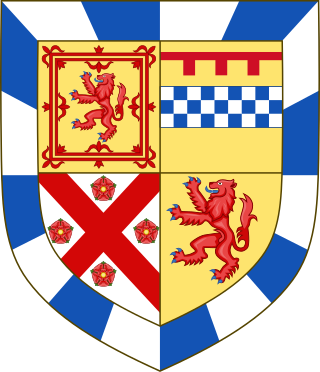Related Research Articles
Colin Campbell, 6th Earl of Argyll was a Scottish nobleman and politician. He was appointed to the Lord Chancellorship of Scotland.

The Lords of the Congregation, originally styling themselves the Faithful, were a group of Protestant Scottish nobles who in the mid-16th century favoured a reformation of the Catholic church according to Protestant principles and a Scottish-English alliance.

James Hamilton, 1st Earl of Arran and 2nd Lord Hamilton was a Scottish nobleman, naval commander and first cousin of James IV of Scotland. He also served as the 9th Lord High Admiral of Scotland.
Patrick Ruthven, 3rd Lord Ruthven played an important part in the political intrigues of 16th century Scotland. He succeeded to the lordship in December 1552. The Ruthven lordship encompassed the offices of Provost and Constable of Perth, and Sheriff of Strathearn.

Henry Stewart, 1st Lord Methven was Master of the Scottish Artillery and third, and last husband, of Margaret Tudor, eldest daughter of Henry VII of England and Elizabeth of York.
John Stewart, 2nd Earl of Atholl was the second Earl of Atholl. He fought in the Battle of Flodden on 9 September 1513.

Andrew Stewart, 1st Lord Avondale was a Scottish nobleman.
Lord Methven was a title in the Peerage of Scotland. It was created on 17 July 1528 by King James V of Scotland for his stepfather Henry Stewart. The title became extinct on the death of the grantee's grandson in the 1580s. The title takes its name from Methven in Perthshire.

Andrew Stewart, 2nd Lord Avondale or Andrew Stuart, 1st Lord Ochiltree, was a Scottish peer.

Andrew Stewart, 2nd Lord Ochiltree fought for the Scottish Reformation. His daughter married John Knox and he played a part in the defeat of Mary, Queen of Scots at the battle of Langside.

Andrew Stewart, 1st Baron Castle Stuart (1560–1629) was a Scottish nobleman, soldier, courtier to King James VI and I and one of the chief undertakers in the Ulster Plantation. Stuart resigned his title "Lord Ochiltree" and was made "Baron Castle Stuart".
John Gordon, 11th Earl of Sutherland (1525–1567) was a Scottish magnate. John Gordon supported the chief of his family, his cousin the Earl of Huntly against the Earl of Moray. After Huntly's defeat at Corrichie, he went into exile, and shortly after his return to Scotland he was murdered by a kinswoman.
John Stewart, 5th Earl of Atholl, (1563–1595) was a Scottish landowner.
Margaret Stewart, Mistress of Ochiltree was a courtier in the household of Anne of Denmark in Scotland and looked after her children Prince Henry, Princess Elizabeth, and Charles I of England

Robert Elphinstone, 3rd Lord Elphinstone (1530-1602) was a Scottish landowner and courtier.

Alexander Elphinstone, 2nd Lord Elphinstone (1511-1547) was a Scottish landowner.
John Stewart, 1st Earl of Atholl (1566-1603) was a Scottish landowner.
Marie Ruthven, Countess of Atholl, was a Scottish aristocrat.

Dorothea Stewart, Countess of Gowrie was a Scottish aristocrat. The dates of the birth and death of Dorothea Stewart are unknown.

Hugh or Huw Kennedy of Girvanmains was a Scottish courtier, soldier, and landowner.
References
- ↑ Fraser, William, Sutherland Book, vol. 1 (Edinburgh, 1892), pp. 90-98
- ↑ James Balfour Paul, Accounts of the Treasurer of Scotland, vol. 10 (Edinburgh, 1913), p. l.
- ↑ HMC 9th Report: Elphinstone (Lonndon, 1884), p. 191-2.
- ↑ HMC 9th Report: Elphinstone (Lonndon, 1884), p. 192.
- ↑ Joseph Robertson, Inventaires de la Royne Descosse (Edinburgh, 1863), p. 58.
- ↑ James Scott, A History of the Life and Death of John, Earl of Gowrie (Edinburgh, 1818), pp. 62-3.
- ↑ Annie Cameron, Scottish Correspondence of Mary of Lorraine (Edinburgh, 1927), pp. 443-4.
- ↑ William Boyd, Calendar of State Papers Scotland: 1574-1581, vol. 5 (Edinburgh, 1907), p. 531.